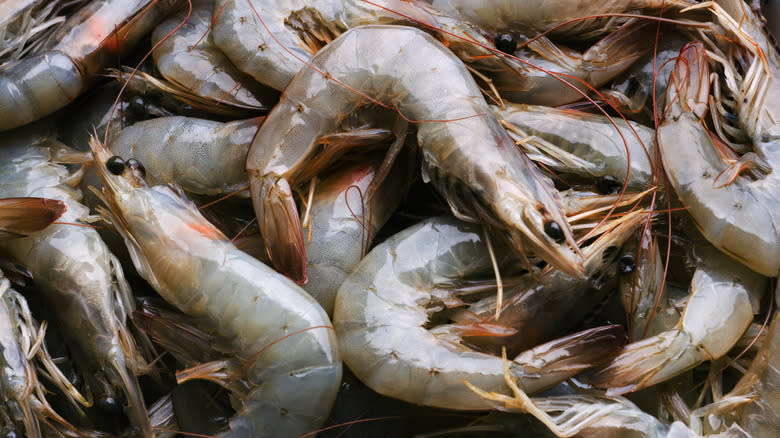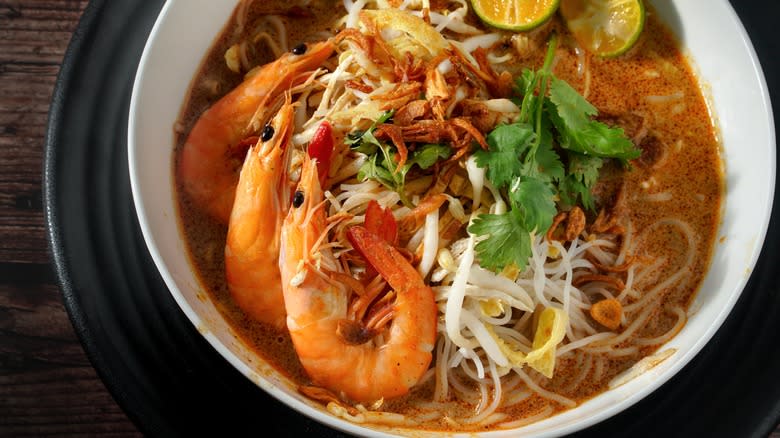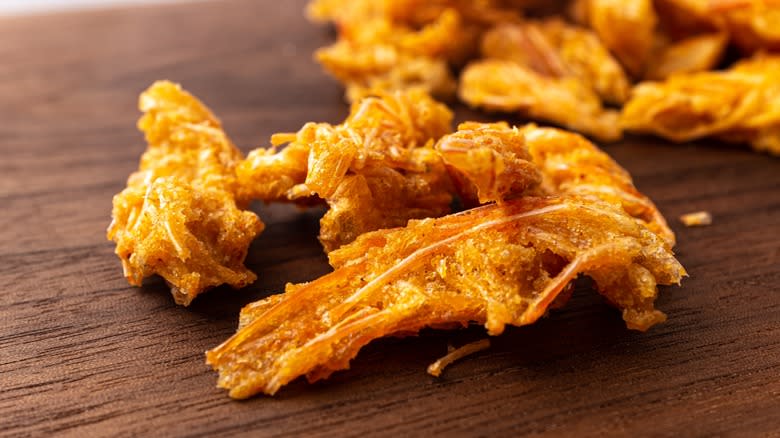If You're Throwing Shrimp Shells Away, You're Making A Big Mistake

We may receive a commission on purchases made from links.
If you've made the realization that shell-on shrimp tends to be cheaper -- and have even learned the not-terribly-difficult art of deveining them yourself -- it's time to take the next step: don't throw the shells away. In fact, start buying your shrimp whole, with their heads on. This isn't just to save you more money, it's because there's an absolute world of flavor you've probably been throwing out with shells and heads when making Caribbean barbecue shrimp. Not only are they indispensable for making sweet, minerally bouillabaisse and stocks for soup and bisque, you can also eat them. Yes, you read that right.
Something happens to shrimp shells when sautéed in butter: the heat and fat not only turns them a deep red; it also caramelizes their sugars, transforming them into an exquisite complement to the shrimpy flavor of the meat. Cover the sautéed shells with water and throw in a chopped shallot and some aromatics like bay leaf, fresh parsley, and black peppercorns, and you'll soon have yourself the base for a magnificent seafood Newburg sauce or a risotto stock that's practically ready to use in the time it takes you to toast the Arborio.
Read more: 13 Tips To Make Your Shrimp Taste So Much Better
Making Stock Of The Situation

As with any stock, you can tailor shrimp stock to fit the dish you'd like to cook. Want to go Low Country and whip up some shrimp and grits? Make the stock with butter, onion, celery, bay, and a pinch of cayenne pepper and use it to not only make the grits but deglaze the pan after sautéing the shrimp. No elegant French shrimp bisque would be complete without a stock made with shrimp shells sautéed in butter and flambéed with cognac (trust us, you want to have this experience: there's nothing like the sight --- and smell! - of blue flames dancing around reddened shells).
Packed with their own kind of flavorful fat and sweet, minerally juices, shrimp heads make a wonderful stock. In fact, some recipes like Malaysia's penang hokkien mee (or prawn noodle soup) are built on a broth made from shrimp heads. In the case of this dish -- which also includes pork ribs, noodles, bean sprouts, and crisp-fried shallots -- the heads are simply boiled for a couple of hours in water until the stock is cloudy. Since this process depends on, well, a lot of shrimp heads, store them in a resealable plastic bag in the freezer until you've accrued enough to make the stock.
Tasty Fried Shrimp Shells (And Heads!)

Sure, you can make stock with shrimp heads and shells, but surely they're not edible, right? No, they totally are. You can make the famous salt and pepper shrimp by deveining the shrimp (while leaving their shells on), coating in cornstarch and deep frying. The shells will become crisp and tasty -- which they will also be if you just coat and fry them on their own, accompanied either by Szechuan peppercorns or Chinese five spice.
You can absolutely leave the heads on when making salt and pepper shrimp, provided you remove the long antenna first. Or, you can just take the heads and fry 'em up too, for a crunchy, shellfishy snack. It shouldn't come as a surprise that eating the entire shrimp (or prawn) has been trending: people are beginning to understand that processed food is not only not necessarily better, it's also wasteful and comes with the added hazards of potential mishandling.
Read the original article on Daily Meal.

